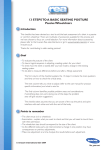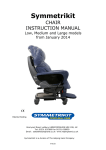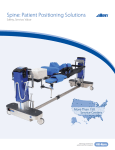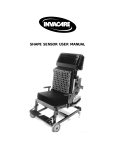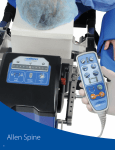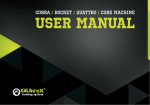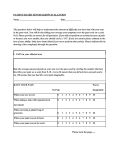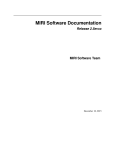Download The 13 steps PH Invacare 110517x
Transcript
WELCOME to 13 steps Preparations of Workshop: Organize yourselves in pairs – you should work two and two together! Do this before we get started - thanks 5/20/2011 13 steps by Pia Hindersson ©Invacare 2011 The 13 steps A European way of analyzing the support areas when being seated 5/20/2011 13 steps by Pia Hindersson ©Invacare 2011 Preparation • Could I have two volunteers? 5/20/2011 13 steps by Pia Hindersson ©Invacare 2011 Just read this!!! • Please study how they sit and take a minute to discuss with your partner • Is it an active position? • Head position? • Position of feet? • Look at them from time to time and see if and how they move 5/20/2011 13 steps by Pia Hindersson ©Invacare 2011 Pia Hindersson • From Sweden – Stockholm • • • • Talk “swinglish” By profession: Occupational Therapist Works for Invacare as Global Product Manager Product area: Passive wheelchairs/ Tilt is Space 5/20/2011 13 steps by Pia Hindersson ©Invacare 2011 Agenda • • • • • • • • Short introduction Posture´s - good and bad – what judges The reason for the 13 steps Palpation and handgrips The 13 step video Practicing the 13 steps Further posturing End of the workshop! 5/20/2011 13 steps by Pia Hindersson ©Invacare 2011 Introduction • Europe – 14 countries • 14 Reimbursement system • North´s more seating and posturing vs. south 5/20/2011 13 steps by Pia Hindersson ©Invacare 2011 Reimbursement effect • Different directives give different solutions • Stipulation vary between - cost level - functional product demands - diagnose - tenders up to four years or a mix between some or all • Effects the product offer 5/20/2011 13 steps by Pia Hindersson ©Invacare 2011 Difference Europe vs. North America PRODUCT PERSPECTIVE • In Europe as a producer you design the complete wheelchair including the seating and options • Seat cushion often changed – preventive reason • All have seat tilt (25°) and backrest recline (30°) • Wheelbases are used for 5-8% for either alternative seat and backrest/ molded seats 5/20/2011 13 steps by Pia Hindersson ©Invacare 2011 Difference Europe vs. North America PRESCRIBER (OT/ PhT´s) PERSPECTIVE • OT/ PhT prescribe the wheelchair • In Europe prescriber have an influence of brand • Makes the assessment more or less in conjunction with the Dealer/ TAC • Assessment part of the rehabilitation inc. follow-up • Most countries have refurbishment schemes • User do not pay 5/20/2011 13 steps by Pia Hindersson ©Invacare 2011 Difference Europe vs. North America USER PERSPECTIVE • Mainly elderly users – 80% geriatric care • In Europe can the user in most countries have a decubitus seat cushion for preventive reasons • Can get a new chair when there is a new functional demand - vary between countries • Users in Nursing homes receive a tilt in space wheelchair 5/20/2011 13 steps by Pia Hindersson ©Invacare 2011 The volunteers - Please freeze your posture 5/20/2011 13 steps by Pia Hindersson ©Invacare 2011 Posture´s • • • • How are the volunteers doing? What happened to their posture? Active or Passive? How do you define it? 5/20/2011 13 steps by Pia Hindersson ©Invacare 2011 How do we get to this posture? - Please work in groups of two and two together. Two observes from each side, one sit and one tilt • Stand behind and tilt your colleague • Ask her to stay active! • What happens with her head? Her pelvis? • What effects will the backward tilted posture have on the body? 5/20/2011 13 steps by Pia Hindersson ©Invacare 2011 What is effected by this posture • Head seeks balance due to Postural reflex • Back becomes kyphotic and increased cervical lordosis • Buttocks move forward on the seat giving a shorter seat • Increases pressure on vertebral discs • Incorrect body weight distributions giving risk of decubitus • Impedes digestion, respiration and blood circulation 5/20/2011 13 steps by Pia Hindersson ©Invacare 2011 Why? (– if we are interested) ZZZZZZhh - not interested Option one: • When being tilted - Postural reflexes Option two: • Sitting in a chair (no tilt) giving poor support, the body will seek support, automatically 5/20/2011 13 steps by Pia Hindersson ©Invacare 2011 What is a good posture? • We are made for standing and being active • When we sit, we should strive for not damaging our bodies – do we? • When we sit we have to allow stability for being mobile – if not having it, we make it happened • The body seeks support! 5/20/2011 13 steps by Pia Hindersson ©Invacare 2011 Basic points to consider • The head would like to have ears and eyes balanced and straight line to Trochanter • The pelvis should be as neutral as possible and supported • Hamstrings should be relaxed • Large contact area 5/20/2011 13 steps by Pia Hindersson ©Invacare 2011 Reason for the 13 steps • Many criteria's to consider • Take one thing at the time • Evaluate over time 5/20/2011 13 steps by Pia Hindersson ©Invacare 2011 Palpation Pelvis • Use your hands as thumb gloves • Find the pelvic edge on your selves – follow it from standing to sitting • Repeat on your partner 5/20/2011 13 steps by Pia Hindersson ©Invacare 2011 Palpation Pelvis – back and forth´s • Sit as low so pelvic edge meet your eye level • Find the pelvic edge, ask your partner too rotate the pelvis slowly back and forward. Note how your index fingers change in height 5/20/2011 13 steps by Pia Hindersson ©Invacare 2011 Palpation Pelvis – oblique • Place the seat mat under one buttock • Let your partner find out if it is left or right with closed eyes! 5/20/2011 13 steps by Pia Hindersson ©Invacare 2011 Palpation Pelvis – rotation Tuber ischiadicum needs space! • Sit on a table – relax!! • Lean back and forth with your pelvis and watch the knees and your shoulders 5/20/2011 13 steps by Pia Hindersson ©Invacare 2011 Palpation Hamstrings • Becomes shorter over time! • Find them on yourselves! 5/20/2011 13 steps by Pia Hindersson ©Invacare 2011 Palpation Hamstrings • Sit it front of your partner • Find them on your partner • Lift the leg slowly and feel the tension increase • Discuss what happens with the pelvis when hamstrings are tense 5/20/2011 13 steps by Pia Hindersson ©Invacare 2011 Palpation • Contact area – define the contact area on your partner - the area where the body meets the seat surface. • Check for pressure difference between seat and backrest 5/20/2011 13 steps by Pia Hindersson ©Invacare 2011 The 13 steps giving Confident Posture for the Elderly User by Invacare® Passive wheelchairs 5/20/2011 13 steps by Pia Hindersson ©Invacare 2011 Introduction This checklist has been devised as a tool to aid the basic assessment of a client in a passive or comfort wheelchair. There are multitude of accessories available for this process and we have chosen to focus on a small selection. For more information about accessories, please refer to the Invacare Rea sales literature or go to www.invacare-rea.com or www.invacare.co.uk Thanks for contributing to safer seating posture! 5/20/2011 13 steps by Pia Hindersson ©Invacare 2011 Goal • To evaluate the posture of the client • To have a logical sequence in adjusting a seating system for your client • To check how the client is seated after you have made a change in the existing seating system • To be able to measure differences before and after a fitting/ assessment 5/20/2011 13 steps by Pia Hindersson ©Invacare 2011 The first column of the checklist explains the 13 steps. It contains the main questions and hints on how to check the critical areas. The next column tells you what to adjust (refer to the user manual for product specific information) and what to aim for. The final column identifies possible problem areas and considerations: if something does not work during one of the steps, the problem area will give solution suggestions. The checklist takes assumes that you are aware of the way the pelvis and spine interface with each other and with the rest of the body. 5/20/2011 13 steps by Pia Hindersson ©Invacare 2011 Points to remember • The client must sit in a wheelchair. • Examination - explain what you want to check and that you will need to touch them - with their permission. • The wheelchair sizes should correspond to the size of the client. • As the different body parts are interconnected a change in one position may have consequences on previous adjustments. • Make one adjustment at a time. Analyze the results before each adjustment. 5/20/2011 13 steps by Pia Hindersson ©Invacare 2011 13 step sequence 1. Mapping the user and Preparations 2. Position of buttocks in the chair 3. Pelvis symmetry 4. Position of the feet 5. Position of thighs 6. Seat angle and cushion 7. Back angle 8. Back height 9. Back shape 10. Arm rest 11. Lateral / trunk support 12. Head support 13. Tilt in space 5/20/2011 13 steps by Pia Hindersson ©Invacare 2011 The 13 steps giving Confident Posture WORK SHOP with Video and Papers 5/20/2011 13 steps by Pia Hindersson ©Invacare 2011 Checklist What to adjust and the aim Possible problem areas/ Considerations I. I Mapping the user A. B. C. D. E. Activities in daily living Physiological condition Psychological factors Social situation Economical factors Remember that the client relatives, therapist, etc. may have different opinions about goals I. 2 Preparations 1. Tilt and recline the chair slightly 2. Remove the legrests 3. Put a cushion or support under the feet 5/20/2011 Relaxed feet position The Hamstrings should be relaxed. This is achieved naturally if the user can move their feet to a preferred position 13 steps by Pia Hindersson ©Invacare 2011 Checklist What to adjust and the aim 2. Position of buttocks in the chair Is the client sitting as far into the seat as possible? Should the backrest be slightly reclined? Seat depth Possible problem areas/ Considerations Check pressure distribution of the buttocks with your hand comparing backrest with seating The client should sit as far back as possible Lean the client forward and check the position from above by palpating the buttocks. The upper inside of the calf should not touch the seat cushion. Strive for a 2-3 cm space To be done before and after the adjustment 3. Pelvic symmetry 5/20/2011 Palpate SIAS/ ASIS Seat width Check whether the two upper pelvic edges are level. After adjustment, check pressure with two fingers, between side guard and Trochanter Should be as narrow as possible without allowing direct pressure Kneel in front of the client so you are at eye level with your hands when palpating SIAS/ ASIS The armrest sides should “just” touch the buttock sides at Trochanter area 13 steps by Pia Hindersson ©Invacare 2011 Checklist What to adjust and the aim Possible problem areas/ Considerations 4. Position of the feet 1. Check hamstring tightness 2. Choose and add legrests that correspond to the preferred position that the client has selected. 3. Check if the feet are bearing weight 4. Check height of foot plate 5. Check pelvis position by SIAS Footrest height, angle and depth Legrests angle Calf pad support – adjust height and depth The feet should be positioned so the pelvis is in a natural position Hamstrings should never be tight – it will pull the pelvis into a backward rotation! Check hamstring tendons for relaxed position Pressure applied under the soles of the feet stimulate upright posture and help to keep them on the footplates Use two fingers for pressure checks at cushion level – both top and front 5. Position of thighs 5/20/2011 Check if the thighs are parallel and straight and facing forward Adjust the width of the legrests to avoid pressure on knees Check that the hamstrings are relaxed The legs should be as straight as possible The upper legs should not be abducted, adducted or windswept 13 steps by Pia Hindersson ©Invacare 2011 Checklist What to adjust and the aim Possible problem areas/ Considerations 6. Seat angle and cushion 1. Assess how the body pressure should be divided between seat and backrest 2. Create a stable sitting position 3. Insert your hand between client and seat, little finger first, and feel the pressure both before and after the adjustment. 4. Check patient for comfort 5. Check risks of decubitus (pressure ulcer) – use the Norton scale or similar and proceed accordingly 5/20/2011 Adjust the seat angle (tilt) with the lever at the rear of the backrest There should have a large contact area between seat and backrest Make sure that you have a seat cushion that allows enough space for the ischial tuberocities The seat should be tilted just enough to maintain balance and feel secure. Check that eyes and ears are level: this ensures that the client remains alert 13 steps by Pia Hindersson ©Invacare 2011 Checklist What to adjust and the aim Possible problem areas/ Considerations 7. Back angle 1. Check position of head and how it is balanced in the spine Adjust the backrest angle with the lever at the rear to a relaxed position 2. Lean the client forward and check the position from above by palpating the both buttocks Ears and eyes should be parallel with the floor and the complete backrest should support the backrest of the client To avoid sliding out of the chair, have the backrest as upright as possible Check for comfort 8. Back height 5/20/2011 Check for comfort and mobility Adjust the backrest height Check with your hand for pressure distribution The support should be at least up to the client’s arm pits Make sure that the shoulder blades are not pushed forward 13 steps by Pia Hindersson ©Invacare 2011 Checklist What to adjust and the aim Possible problem areas/ Considerations 9. Back shape Check support of preferred posture. Use your hand for pressure evaluation If not sufficient adjust with wedges or/ and the tension-adjustable backrest Strive for a natural pelvic position. Ensure that firm support is given just at the upper pelvis (sacrum-iliac joint) to avoid backward rotation of pelvis Strive for mobility movement without locking the posture 10. Arm rest Evaluate the support both for upper and lower trunk by giving stabilisation with your hands 11. Lateral / trunk support Create upper body stability Adjust height and depth Does it give support during transfer/ body shifting? Shoulder area should be relaxed Adjust the depth and height Could another backrest cushion/ backrest base give better support? The body posture should be stable thanks to rear rather than side support 5/20/2011 13 steps by Pia Hindersson ©Invacare 2011 Checklist What to adjust and the aim Support area for cartransportation 12. Head support Adjust height and angle and loosen all screws then adjust from the bottom to the top Check the reason: 1. Support during transportation 2. Tilt in space Possible problem areas/ Considerations Support area for normal use Neck and headrests should be used when seat angle is > 105º 13. Tilt in space 5/20/2011 Check interval of relevant use Adjust the backrest angle with the lever at the rear Make a final check with your hand around the user for distribution of pressure - this will indicate if optimum support is being given Tilt should be used in short period for weight and pressure distribution purposes As tilt increases, the pressure distribution transfers from the seat to the backrest area Please note that a greater tilt angle increases drowsiness and decreases activity levels 13 steps by Pia Hindersson ©Invacare 2011 Additional support Where would you like to have more support? Define those and built up the seat by adding bits and pieces 5/20/2011 13 steps by Pia Hindersson ©Invacare 2011 Additional support Ask your partner to stand up – do they have the same shape of the spine, position of the head and pelvis when sitting? If so - you are done! 5/20/2011 13 steps by Pia Hindersson ©Invacare 2011 That was all from me – thank you for your attention www.invacare-rea.com 5/20/2011 13 steps by Pia Hindersson ©Invacare 2011











































